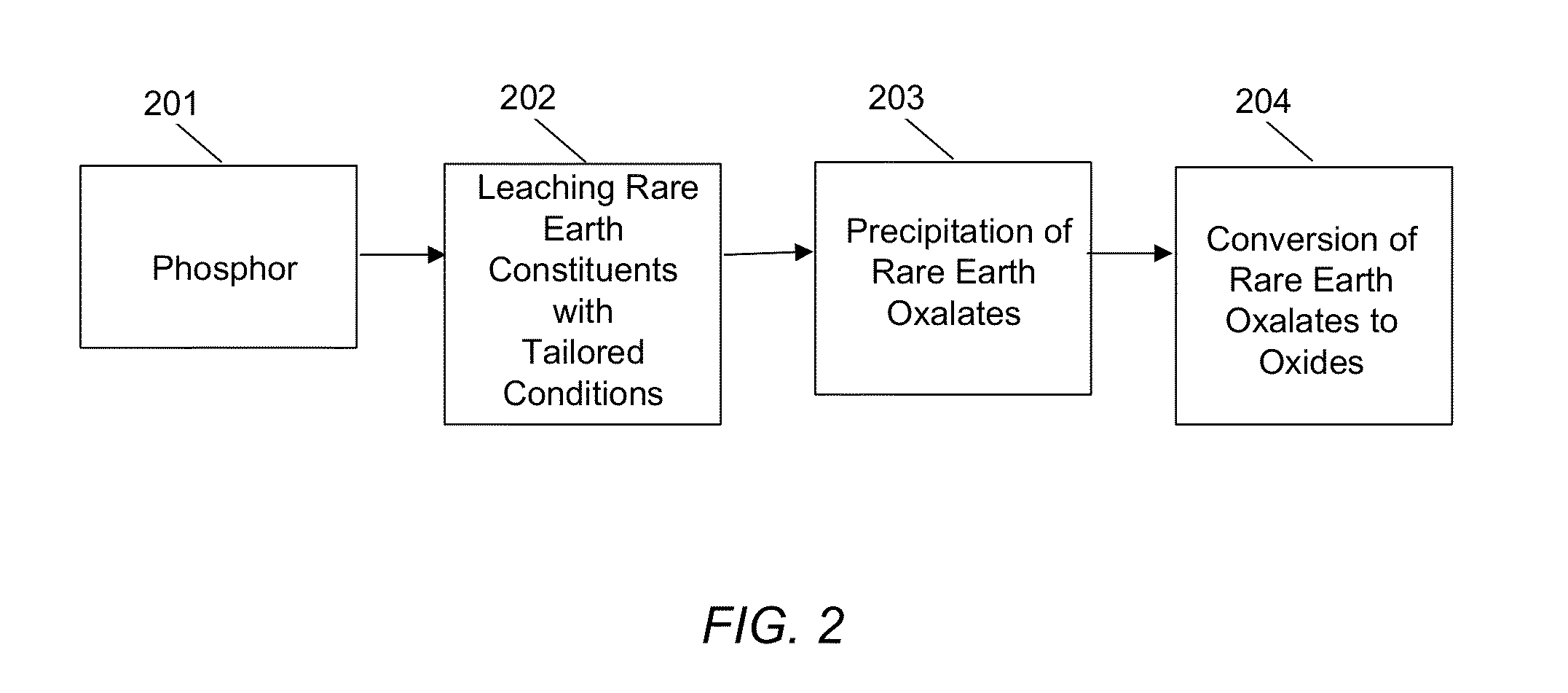Rare earth recovery from phosphor
a technology of rare earth elements and phosphor, which is applied in the direction of rare earth metal nitrates, physical/chemical process catalysts, lanthanide oxides/hydroxides, etc., can solve the problems of environmental taxation, process is expensive and time-consuming, and requires additional concentration steps, etc., to achieve efficient and effective methods
- Summary
- Abstract
- Description
- Claims
- Application Information
AI Technical Summary
Benefits of technology
Problems solved by technology
Method used
Image
Examples
example 1
Two-Stage Leaching Followed by Purification
[0061]In one embodiment of the invention, the leaching with H2SO4 was accomplished in two stages, as shown in FIG. 3 and as described below:
[0062]500 grams of phosphor powder 1 were added slowly into a glass beaker containing 3 liters of H2SO4 (6N) 2 under constant agitation with a mechanical stirrer. The rate of stirring was set to 200 revolutions per minute (rpm). This solution was heated for 4 to 6 hours, while maintaining the speed of stirring. The temperature of the solution was maintained around 90° C. After leaching for about 4 to 6 hours, the volume of the solution was increased to 5 liters with the addition of water, while continuing with the stirring. The solution thus obtained was filtered 3 using a Buchner funnel under suction. The un-leached residue was then washed thoroughly with very dilute H2SO4 to remove rare earths adsorbed in the residue. After washing the residue, the filtrate was collected and tested for La, Ce, Eu, Tb ...
example 2
Single-Stage Leaching Followed by Purification
[0074]In another embodiment of the invention, the leaching with H2SO4 was accomplished in one stage, as shown in FIG. 10 and as described below: 500 grams of phosphor powder 84 were added slowly into a glass beaker containing 500 ml of concentrated H2SO4 (about 36N) 85 under constant agitation with a mechanical stirrer. The rate of stirring was set to 120 revolutions per minute (rpm). This solution was heated for 6 hours, while maintaining the speed of stirring. Temperature of the solution was maintained around 150-170° C. After leaching for 6 hours and cooling for 3-4 hours, the volume of the solution was increased to 5 liters by adding this solution to water slowly, while continuing with the stirring. The solution thus obtained was filtered 86 using a Buchner funnel under suction. The un-leached residue was then washed thoroughly with very dilute H2SO4 to remove rare earths adsorbed in the residue. After washing the residue, the filtra...
PUM
| Property | Measurement | Unit |
|---|---|---|
| temperature | aaaaa | aaaaa |
| boiling point | aaaaa | aaaaa |
| extraction efficiency | aaaaa | aaaaa |
Abstract
Description
Claims
Application Information
 Login to View More
Login to View More - R&D
- Intellectual Property
- Life Sciences
- Materials
- Tech Scout
- Unparalleled Data Quality
- Higher Quality Content
- 60% Fewer Hallucinations
Browse by: Latest US Patents, China's latest patents, Technical Efficacy Thesaurus, Application Domain, Technology Topic, Popular Technical Reports.
© 2025 PatSnap. All rights reserved.Legal|Privacy policy|Modern Slavery Act Transparency Statement|Sitemap|About US| Contact US: help@patsnap.com



